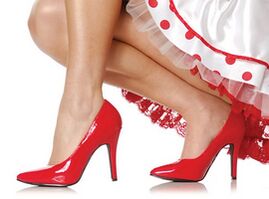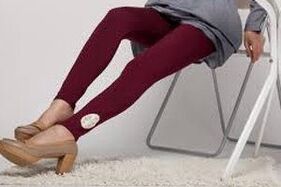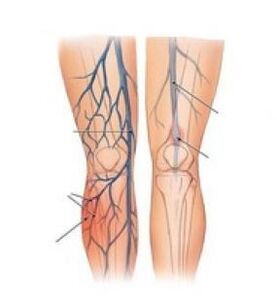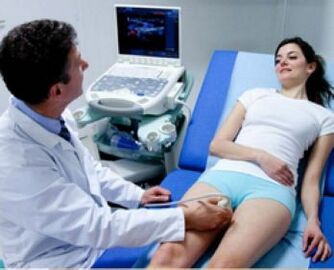Varicose veins are a common venous disease that mainly affects women's legs. Its essence lies in the dilation or elongation of the veins in the lower extremities, which ultimately leads to a thinning of the venous walls. The disease cannot be ignored as it can lead to serious complications such as venous insufficiency of the legs, thrombosis, bleeding and gangrene.
The disease cannot be ignored as it can lead to serious complications such as venous insufficiency of the legs, thrombosis, bleeding and gangrene.
Gangrene is dangerous because if left untreated, it can lead to leg amputation, thrombosis and even the death of the patient - the detached blood clot reaches the heart, which will provoke his arrest. Early treatment of the disease is essential before complications develop.
Causes
Scientists have proven that varicose veins are inherited. If your relatives have been diagnosed with varicose veins, it is likely that you will develop it.
The following reasons may cause your development:
- hormonal disorders;
- pregnancy;
- high load on the legs;
- bad habits;
- hypodynamics.
The main natural cause of leg varicose veins is increased vascular load. Exertion can occur due to both physical inactivity and increased physical activity. The office lifestyle often leads to varicose veins - spending a huge amount of time sitting or standing. In this case, the blood circulation is interrupted, stagnant areas develop, which then leads to vascular degradation.
The office lifestyle often leads to varicose veins - spending a huge amount of time sitting or standing. In this case, the blood circulation is interrupted, stagnant areas develop, which then leads to vascular degradation.
An unhealthy diet also increases the chances of varicose veins. The disease can be caused by increased consumption of fatty foods, fast foods, cholesterol, caffeine. All this negatively affects the health of the veins. Excessive physical activity is also harmful.
Pregnant women are also at risk. The physical characteristics of pregnancy disrupt the proper blood supply to the legs, often causing the development of varicose veins. In addition to insufficient blood supply to the legs, the hormonal condition of pregnant women also changes, which can also cause disease. During this period, it is advisable to check the condition of the legs regularly, in case of pain, consult a doctor immediately. Inflammatory veins may disappear after the baby is born, but you can wear special drapery underwear for prevention.
Symptoms
You can suspect the development of varicose veins with a variety of symptoms:
- Swelling of the legs. Reinforcement towards the end of the working day is a common feature. <2_img_rxx>
- Calf pain is an early sign.
- Sudden leg cramps.
- Prolonged healing of wounds and bruises is a late symptom.
- An increase in the size of veins, the appearance of winding pathways or nodules is an early sign.
- Hair loss from the inner surface of the legs, thickening of the skin in this area is a late symptom.
An important feature of the manifestation of symptoms is that they increase in the evening or without staying on long legs or moving. If you find at least one symptom of the disease, it is recommended to see a doctor immediately. The diagnosis of varicose veins is performed by phlebologists - specialists in veins. Routine examination is not sufficient to establish a diagnosis, Doppler ultrasound is required. If necessary, varicose veins can be confirmed by radionuclide or radiopaque methods. In this case, the distribution of the specially introduced substance in the vessels is examined.
Treatments

The occurrence of varicose veins has stimulated the creation of many options for its treatment, both medical and folk. If possible, contact your doctor, who will tell you exactly how to treat you based on your individual characteristics. It is advisable to use folk methods only in the absence of the possibility of professional treatment. They relieve the symptoms of the disease but do not eliminate the cause.
Medication
All medications fall into two major groups: topical and generic medications. It should be understood that medication is only relevant in the early stages of the disease. In advanced cases, medication is also used, only to prevent the spread of the disease.
Anticoagulants are the most popular in treatment. They dilute the blood, prevent vasodilation, which reduces the risk of blood clots. They can also be taken orally and in the form of gels and ointments or injections. Dosage and selection of a particular drug should only be entrusted to the treating physician. Angioprotectors help to improve the microcirculation of blood vessels, thereby eliminating the cause of the disease.
leeches are also used to treat varicose veins. When they bite, a natural special substance, hirudin enters the body. This dilutes the blood, which reduces the risk of blood clots. This method is less effective than medication, but for some it is the only possible method. Treatment with leeches is cyclical.
This dilutes the blood, which reduces the risk of blood clots. This method is less effective than medication, but for some it is the only possible method. Treatment with leeches is cyclical.
Surgical treatment
The essence of surgical treatment is to exclude or completely remove the patient's veins from the circulatory system. Most often, such procedures are performed by injecting a special substance into a vein that glues it together from the inside. The most effective method that is not dangerous to health is surgical removal of damaged veins. However, the general condition of the circulatory system will be virtually unaffected. The veins that cause varicose veins only pass through up to 10% of the blood flowing in the legs. Their removal strains the rest of the veins but does not cause significant damage to health.
Alternative Treatment
It is possible to treat varicose veins with folk remedies, but at your own risk. Most of these methods are ineffective in the early stages of the disease and ineffective in the later stages. Alternative treatments alleviate the symptoms of varicose veins but do not cure them, which is especially dangerous in advanced cases. Such a trip is dangerous to your health.

The most popular folk recipes that can be used to treat varicose veins are:
- Apple cider vinegar
- earthworm;
- nettle;
- garlic.
Apple cider vinegar can heal blood vessels from the outside, relieving flare-ups even in young people. Sore spots are treated twice a day. The vinegar is diluted in the bath and the feet are placed in it for 5 minutes. After such procedures, we recommend that you allow your feet to dry on their own. Garlic is used as an ointment. To make, mix one part garlic with two parts butter. The resulting hoarfrost is applied to the affected areas of the legs at night.
Prevention
Prevention is universal and allows not only the prevention of varicose veins, but also the improvement of health, the elimination of symptoms and, as a result, the improvement of well-being.
Main preventive measures:
- healthy food;
- sports;
- Lack of high load on the veins.
Healthy eating involves using fruits and vegetables in your diet, especially raw. Eating nuts and seafood also has a beneficial effect on vascular health. In this case, you should forget about products that contain very fatty and salty foods, alcohol and caffeine.
Regular exercise improves blood flow to the legs, which has a positive effect on the health of the veins. Don’t exercise too much - running and moderate cycling are great. It is important to exercise regularly, even while sitting, without letting the blood stagnate. Crossed legs are contraindicated in sitting work.
Varicose veins are a disease that is important to treat at an early stage. Do not be afraid of your doctor when the first symptoms appear. Today, treating varicose veins on women’s legs is not as expensive as it used to be, nor is it dangerous to the body. By starting a pre-treatment, it will provide health and comfort to your feet for many years to come.












































